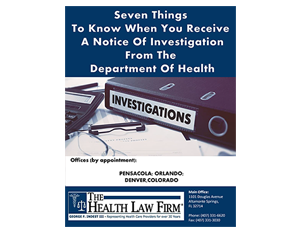Call: (407) 331-6620 or (850) 439-1001
Toll-free: (888) 331-6620

Seven Things To Know When You Receive A Notice Of Investigation From The Department Of Health
Whether or not we know it, we are under camera surveillance nearly any time we are in a public place. Generally, these cameras do not invade our privacy because we have no expectation of privacy in public places. But their introduction into congregate care facilities such as hospitals, nursing homes and skilled nursing facilities can set a facility up for legal trouble.
Currently, most congregate care facilities use surveillance cameras to monitor activity in the public part of their facilities. There has been growing demand by patients’ family members for video monitoring in private patient care areas. Some families even have installed hidden cameras.
The use of cameras in these areas creates a significant patient privacy problem for facilities. Congregate living facilities are covered entities under HIPAA and a patient’s medical information, including visual information, is protected. Allowing a resident to be video-recorded without their consent may violate HIPAA and result in the imposition of sanctions by the Office of Civil Rights.
Whether the person being taped can give consent for video surveillance is another concern for the congregate living facility. Although the resident may not be competent to consent to matters concerning their care and financial arrangements, competence is not a black-and-white issue. The patient still may be able to decide whether a video camera can be used even if that individual is not competent to make all of his or her own decisions.
A camera intended to monitor one resident who has consented to its use also may inadvertently capture another resident who has not consented. Depending on the facts of the case, this very easily could result in an invasion of privacy lawsuit.
Using cameras that record audio can be considered eavesdropping or wiretapping depending on how the conversation took place. Most states allow a conversation to be recorded if one participant in the conversation consents, but 12 states require both parties to the conversation to consent before the conversation can be recorded. While the resident may have consented to the use of the camera with audio capabilities, the consenting resident may not always be a party to a conversation recorded by the equipment. Most likely, individual caregivers will not have given their consent to have their conversations recorded and they may be the only individuals engaged in the conversation.
As the cost of video monitoring equipment continues to decrease, more and more people may consider installing a camera in the patient room. Currently, only three states have laws that permit nursing home residents to place video cameras in their private rooms. Congregate care facilities administrators still will need to consider each request on an individual basis and carefully weigh the risk to residents and their own facility.
Main Office • 1101 Douglas Ave., Ste 1000, Altamonte Springs, FL 32714 • (407) 331-6620
By Appointment • 5401 S. Kirkman Road, Suite 310, Orlando, FL 32819 • (888) 331-6620
By Appointment • 201 East Government Street, Pensacola, FL 32502 • (850) 439-1001
By Appointment • 201 St. Charles Ave., # 2500, New Orleans, LA 70170 • (888) 331-6620
Medicare/Medicaid Audits, Health Care Law, Contracts, Hospital Privileges Hearings, Investigations, DEA Defense, Board of Medicine Defense, Healthcare Fraud Defense, Medical Staff Fair Hearings, Administrative Hearings, PRN, IPN, Professional Licensing, Medicare/Medicaid Fraud Defense, Nursing Law, Hospital Peer Review, Hospital Law, Board of Dentistry, Board of Nursing Complaint Defense, Board of Pharmacy, Medicaid Fraud Control Unit (MFCU) Defense, Search Warrant and Subpoena Defense, NBME Representation, USMLE Challenges, ABIM Representation, Resident Physician Defense, VA & Military Physician Defense, Department of Health Investigation Defense, and more…
Available in the following Florida cities and counties: Daytona Beach, Fort Lauderdale, Gainesville, Jacksonville, Key West, Melbourne, Miami, Ocala, Orlando, Pensacola, Panama City, Sarasota, St. Petersburg, Tallahassee, Tampa, West Palm Beach, Alachua, Baker, Bay, Bradford, Brevard, Broward, Calhoun, Charlotte, Citrus, Clay, Collier, Columbia, Dade, De Soto, Dixie, Duval, Escambia, Flagler, Franklin, Gadsden, Gilchrist, Glades, Gulf, Hamilton, Hardee, Hendry, Hernando, Highlands, Hillsborough, Holmes, Indian River, Jackson, Jefferson, Lafayette, Lake, Lee, Leon, Levy, Liberty, Madison, Manatee, Marion, Martin, Monroe, Nassau, Okaloosa, Okeechobee, Orange, Osceloa, Palm Beach, Pasco, Pinellas, Polk, Putnam, St. Johns, St. Lucie, Santa Rosa, Sarasota, Seminole, Sumter, Suwannee, Taylor, Union, Volusia, Wakulla, Walton, and Washington
By making this website information available for those who access it does not constitute doing business in or having a presence in any state or jurisdiction, nor does it constitute an advertisement sent to or a solicitation made in any state or jurisdiction. This firm is located in and maintains a presence in only those states where the firm maintains an actual physical office. Its attorneys are only admitted to practice in those states specifically listed on their resumes.
Available in the following states: Alabama, Alaska, Arizona, Arkansas, Connecticut, Delaware, Florida, Georgia, Hawaii, Idaho, Illinois, Indiana, Iowa, Kansas, Kentucky, Louisiana, Maine, Maryland, Massachusetts, Michigan, Minnesota, Mississippi, Missouri, Montana, Nebraska, Nevada, New Hampshire, New Jersey, New Mexico, New York, North Carolina, North Dakota, Ohio, Oklahoma, Oregon, Pennsylvania, Rhode Island, South Carolina, South Dakota, Tennessee, Texas, Utah, Vermont, Washington, West Virginia, Wisconsin, and Wyoming
Disclaimer | Terms of Representation
“The Health Law Firm” is a registered fictitious business name of and a registered service mark of The Health Law Firm, P.A., a Florida professional service corporation, since 1999. Copyright © 2025 The Health Law Firm. All rights reserved.